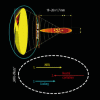High-Intensity Focused Ultrasound (HIFU) in Localized Prostate Cancer Treatment
- PMID: 25806099
- PMCID: PMC4360749
- DOI: 10.12659/PJR.892341
High-Intensity Focused Ultrasound (HIFU) in Localized Prostate Cancer Treatment
Abstract
Background: High-intensity focused ultrasound (HIFU) applies high-intensity focused ultrasound energy to locally heat and destroy diseased or damaged tissue through ablation. This study intended to review HIFU to explain the fundamentals of HIFU, evaluate the evidence concerning the role of HIFU in the treatment of prostate cancer (PC), review the technologies used to perform HIFU and the published clinical literature regarding the procedure as a primary treatment for PC.
Material/methods: Studies addressing HIFU in localized PC were identified in a search of internet scientific databases. The analysis of outcomes was limited to journal articles written in English and published between 2000 and 2013.
Results: HIFU is a non-invasive approach that uses a precisely delivered ultrasound energy to achieve tumor cell necrosis without radiation or surgical excision. In current urological oncology, HIFU is used clinically in the treatment of PC. Clinical research on HIFU therapy for localized PC began in the 1990s, and the majority of PC patients were treated with the Ablatherm device.
Conclusions: HIFU treatment for localized PC can be considered as an alternative minimally invasive therapeutic modality for patients who are not candidates for radical prostatectomy. Patients with lower pre-HIFU PSA level and favourable pathologic Gleason score seem to present better oncologic outcomes. Future advances in technology and safety will undoubtedly expand the HIFU role in this indication as more of patient series are published, with a longer follow-up period.
Keywords: High-Intensity Focused Ultrasound Ablation; Interventional; Magnetic Resonance Imaging; Prostatic Neoplasms.
Figures
References
-
- American Cancer Society. Cancer facts and figures 2009. Atlanta, GA: American Cancer Society; 2009. Prostate cancer facts; pp. 19–20.
-
- European Cancer Observatory. Cancer Fact Sheets. [Accessed December 21, 2013]. Available at: http://eu-cancer.iarc.fr/2-cancer-factsheets.html,en.
-
- Gelet A, Chapelon JY, Margonari J, et al. Prostatic tissue destruction by high intensity focused ultrasound: experimentation on canine prostate. J Endourol. 1993;7:249–53. - PubMed
-
- Gelet A, Chapelon JY, Margonari J, et al. High intensity focused ultrasound experimentation on human benign prostatic hypertrophy. Eur Urol. 1993;23:44–47. - PubMed
Publication types
LinkOut - more resources
Full Text Sources
Research Materials
Miscellaneous



